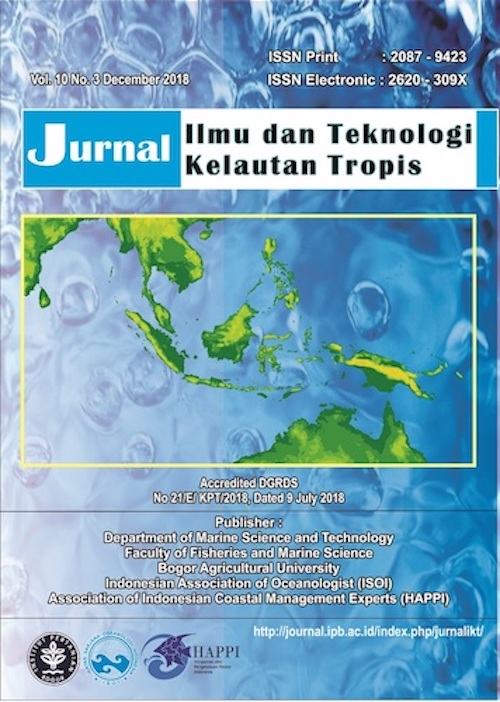STRUKTUR DAN ASOSIASI JENIS LAMUN DI PERAIRAN PULAU-PULAU HIRI, TERNATE, MAITARA DAN TIDORE, MALUKU UTARA
Abstract
ABSTRAK
Keberadaan ekosistem lamun di perairan pesisir pulau-pulau kecil berperan penting sebagai habitat dan penyedia sumber daya ikan, serta pelindung garis pantai dan daratan pulau-pulau kecil tersebut. Penelitian ini bertujuan untuk menganalisis sebaran, komposisi, kerapatan, penutupan dan asosiasi jenis lamun di perairan pulau-pulau kecil Hiri, Ternate, Maitara dan Tidore, Maluku Utara. Pengambilan data dengan menggunakan metode transek garis dan transek kuadrat. Selanjutnya data dianalisis dengan menggunakan bantuan perangkat lunak MS Excel dan XLstat. Hasil penelitian menunjukkan bahwa Pulau Tidore memiliki jumlah jenis lamun terbanyak yakni delapan jenis lamun dari sembilan jenis lamun yang ditemukan di seluruh lokasi penelitian. Tiga jenis lamun yaitu, Enhalus acoroides, Thalassia hemprichii dan Cymodocea rotundata, menyebar luas dan terdapat di keempat pulau tersebut. Komposisi, kerapatan dan penutupan jenis lamun bervariasi antar stasiun penelitian. Vegetasi lamun yang ditemukan di lokasi penelitian berupa vegetasi campuran yang terdiri dari tiga sampai delapan jenis lamun. E. acoroides banyak ditemukan di Stasiun Mtr1 dan Tte2 tidak berasosiasi dengan spesies lainnya, demikian juga dengan C. serrulata yang ditemukan di Stasiun Mtr2 dan T. hemprichii di Stasiun Tdr2 dan Tdr3. Asosiasi C. rotundata dan Syiringodium isoetifolium terlihat di stasiun Tdr1 dan Hr1, sementara Halophila ovalis dan H. spinulosa tidak menunjukkan asosiasi dengan jenis lamun lainnya di lokasi penelitian. Secara keseluruhan kondisi lingkungan perairan di keempat pulau tersebut masih tergolong baik dan mampu mendukung ekosistem lamun.
ABSTRACT
The existence of seagrass ecosystems in the coastal region of small islands has been playing an essential role as a habitat and the supplier of fish resources, as well as a shore and coastline protector of small islands. This study aimed to determine the distribution, composition, density, coverage, and associations of seagrass plant in the islands of Hiri, Ternate, Maitara, and Tidore. Data were collected by using line transect method and quadrate transect. Furthermore, data were analyzed by using MS Excel and XLstat software. The results showed that Tidore Island has the highest number of seagrass species namely eight from nine species of seagrasses found in all research sites. Three species of seagrasses, Enhalus acoroides, Thalassia hemprichii, and Cymodocea rotundata, were widespread in all four islands. The composition, density and coverage of seagrass species varied among research stations. Vegetation of seagrasses found in the study site in the form of mixed vegetation consisting of three to eight species. Enhalus acoroides found mostly in Mtr1 and Tte2 stations were not associated with other seagrass species, nor Cymodocea serrulata that found in Mtr2 Station and T. hemprichii at Tdr2 and Tdr3 stations. The associations of C. rotundata and Syringodium isoetifolium were observed at Tdr1 and Hr1 Stations. While Halophila ovalis and Halophila spinulosa showed no association with other seagrass species at the study area. Overall the condition of the marine environment on the four islands is still relatively good and able to support the life of the seagrass ecosystem.
Authors
The author submitting the manuscript must understand and agree that the copyright of the article manuscript must be submitted/transferred to the Jurnal Ilmu dan Teknologi Kelautan Tropis. This work is licensed under the Creative Commons Attribution-ShareAlike 4.0 (CC BY-SA) International License in which the Author and Reader can copy and redistribute the material in any media or format, and remix, modify and build material for any purpose, but they must provide appropriate credit (citing articles or content), provide a link to the license, and indicate whether there is a change. If you mix, change, or create material, you must distribute your contribution under the same license as the original.


